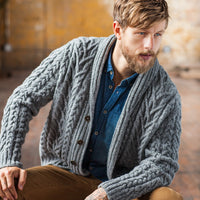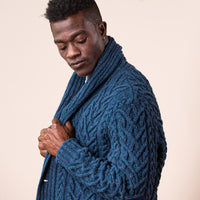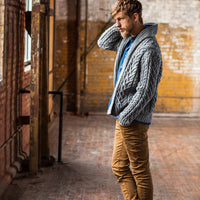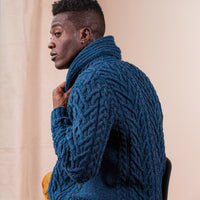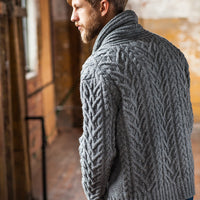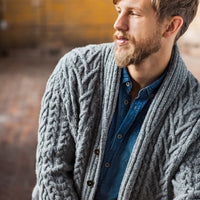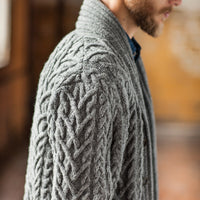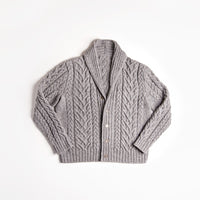Product description
"Cabled cardigans are one of my most beloved wardrobe items. Their true timelessness makes them so versatile. I love combining them with all manner of outfits for instant coziness, either at home or on the road.” — designer, Jared Flood
It’s no wonder this classic cardigan tops the list of our must-knit essentials – in worsted weight Shelter, Tones, or Imbue Worsted, Timberline is a pattern you’ll be proud of knitting and delight in wearing for years to come.
Our updated version offers a wider range of sizes, graded on our unisex block for a great fit for all bodies.
Designer: Jared Flood
Collections: Men Volume 1; BT Essentials
Share on social: #TimberlineCardigan
Share
Timberline
Shawl Collar Cabled Cardigan
-
Product description
"Cabled cardigans are one of my most beloved wardrobe items. Their true timelessness makes them so versatile. I love combining them with all manner of outfits for instant coziness, either at home or on the road.” — designer, Jared Flood
It’s no wonder this classic cardigan tops the list of our must-knit essentials – in worsted weight Shelter, Tones, or Imbue Worsted, Timberline is a pattern you’ll be proud of knitting and delight in wearing for years to come.
Our updated version offers a wider range of sizes, graded on our unisex block for a great fit for all bodies.
Designer: Jared Flood
Collections: Men Volume 1; BT Essentials
Share on social: #TimberlineCardigan
-
Pattern materials
YARN
Choose from Brooklyn Tweed worsted weight wool yarns:
Shelter — 140 yards (128 meters) per 50g skein
- 15 (16, 17, 18) (20, 21, 23) (24, 25, 27, 28) skeins
- Photographed in colors Almanac and Sweatshirt
—OR—
Tones — 140 yards (128 meters) per 50g skein
- 15 (16, 17, 18) (20, 21, 23) (24, 25, 27, 28) skeins
—OR—
Imbue Worsted — 104 yds (95 meters) per 50g skein
- 20 (21, 22, 24) (27, 28, 30) (32, 34, 36, 38) skeins
- Photographed in color Peat
YARDAGE
- 2005 (2110, 2255, 2460) (2720, 2895, 3085) (3270, 3450, 3650, 3875) yards [1833 (1929, 2062, 2249) (2487, 2647, 2821) (2990, 3155, 3338, 3543) meters] of worsted weight wool yarn
NEEDLES
Main needles
- Suggested Size: US 7/4.5 mm
- 40”/100 cm circular needle
- 16”/40 cm circular needle, or longer as preferred
- One set of double-pointed needles (DPNs)
Ribbing needles
- Suggested Size: US 5/3.75 mm
- Two sizes smaller than main needle
- 40”/100 cm circular needle, or longer as preferred
- One set of DPNs
Cast-on needles (optional)
- Suggested Size: US 4/3.5 mm
- One size smaller than ribbing needles
- 40”/100 cm circular needle, or longer as preferred
- One set of DPNs
-
Pattern specs
CONSTRUCTION
- Sleeves are worked circularly from cuff to underarm. After binding off the underarm stitches, the cap is worked flat.
- Cardigan body is worked in one piece for the ribbed hem. Upon completion of the hem, stitches for the front button bands are put on a holder to be worked later. The remaining cabled section of the body is worked in one piece to the underarm.
- After underarm stitches are bound off for the body, both fronts and back are worked separately to the shoulders. V-neck shaping is worked on each front.
- Upon completion of the body, you will return to your held front band stitches and work them separately. Front bands are worked at a firmer gauge than the cabled portion of fabric (using smaller needles). When bands reach the base of the front neck shaping, you will begin working shaping for the shawl collar.
- The shawl collar is shaped with short rows, seamed together at the back neck with a Joinery Bind Off. The edge of the collar is then sewn to the back neck edge of garment.
- The front bands and shawl collar are worked with a 4-stitch selvedge that lays flat; this selvedge is a combination of a 2-stitch I-cord and 2 stitches of 1x1 rib. Instructions for working this selvedge are written into the pattern.
FINISHED DIMENSIONS
1 (2, 3, 4) (5, 6, 7) (8, 9, 10, 11)
- 37¼ (39¾, 43¾, 47¾) (53¼, 57¼, 60¼) (64¼, 68¼, 72¼, 76¼)” [94.5 (101, 111, 121.5) (135.5, 145.5, 153) (163, 173.5, 183.5, 193.5) cm] circumference at chest, buttoned
- See Full Schematic for more sizing information
- Imbue Worsted Peat sample is Size 3. Modeled by Luigi (with mustache), 6'1"/185.5 cm tall, with 5"/12.5 cm positive ease.
- Shelter Almanac sample is Size 5. Modeled by Kojo David (no facial hair), 6’/183 cm tall, with 17”/43 cm positive ease.
- Shelter Sweatshirt sample is Size 4. Modeled by Dennis (with beard), 6’2”/188 cm tall, with 7¾”/19.5 cm positive ease.
Need help picking a size? See our resource page on Selecting a Sweater Size 101.
GAUGE
- 31 stitches & 31¼ rows per 4”/10 cm over cabled fabric with main needle(s), after blocking
- 20 stitches & 31¼ rows per 4”/10 cm in reverse stockinette with main needle(s), after blocking
- 9-Stitch braid motif from cable patterns measures approximately 1¼”/3 cm wide
- 30-stitch large cable motif from cable patterns measures approximately 3¾”/9.5 cm wide
Please note: the stitch patterns in this garment include written as well as charted instructions.
-
Techniques
Tutorials for all special techniques listed below are included in the pattern:
- Video — Italian Tubular Cast On
- Video — Cabling Without a Cable Needle
- Video — Yarn Over Short Rows
- Video — Joinery Bind Off
- Blocking 101
- Seaming 101
-
Pattern Updates
16 December 2024: Version 4.2
On page 16 of the pattern in English, the notes for the Back Setup Pattern and Back Pattern have been updated to read "Note: Instructions in {curly brackets} are worked J ____ (see pattern table on page 23) times each."Additionally, on page 15, Row 1 of the Right Front Pattern (Sizes 1-6 Only) has been updated to read "Slip 1 WYIB, purl 3, ‡purl 1‡, knit 3, 3/3 RC, purl 3, ‡purl 1‡, 3/3 RC, purl 3, 3/1 RC, purl 4, 3/1 LC, purl 3, 3/3 LC, purl 3, ‡purl 1‡, knit 3, 3/3 RC."
6 November 2024: Version 4.1
On page 16 of the pattern in English, Row 9 of the Back Setup Pattern written instructions has been updated to read "Knit 9 ..."1 October 2024: Version 4.0
The pattern in English has been updated with a new format, unisex size-inclusive grading, written instructions for all charts, and new imagery.
18 April 2017: Version 3.1
On page 13, the last paragraph of Left Collar Shaping Sequence B should read:
Upon completion of this section, you will have worked Left Collar Shaping Sequence B 14 times; you now have 57 stitches on your needle.
23 January 2014: Version 3.0
On page 13, under Left Collar Shaping Sequence B, the first 3 stitches have been corrected to read:
“Collar Row B2 (WS): Knit 3, purl 1, knit 2, slip marker, work in established rib to next marker, slip marker, knit 2, purl 3.”
30 October 2013: Version 2.1
The Sleeve cuff measurements were missing on the Schematic and have now been added.
28 August 2013: Version 2.0
Page 6 Column 2 (end) adjusted as follows:
Work as established, repeating Hem Rows 1 & 2 until piece measures 2 1/2″ from cast-on edge, ending with a RS (WS, RS, WS) row.
Sizes 43 3/4 and 53ʺ only:
Place a marker at center of work [after 127 (–, 147, –) stitches].
Next Row (WS): Work in established rib to 4 stitches before marker, p2tog, SSK, remove marker, k2tog, SSP, work in established rib to end. [4 stitches decreased; 250 (–, 290, –) stitches remain]
Page 7 Column 1 (top), adjusted as follows:
All Sizes Resume: Divide Body and Bands
Body Setup Row 1 (RS): Knit 2, purl 1, slip 1 with yarn in back, *purl 2, knit 2; repeat from * 3 more times.
Place the 20 stitches just worked onto waste yarn or a stitch holder (these are your Right Band stitches and will be worked later). Continue across row as follows: Work Row 1 of Right Front Setup Chart once (working increases as indicated), place marker (Marker A), purl 4 (5, 7, 9), M1P, purl 6 (16, 13, 28), M1P, [purl 2 (–, 7, –), M1P] 2 (–, 2, –) times, purl 0 (5, 0, 9), place marker (Marker B), work Row 1 of Back Setup Chart once (working the bracketed motif 3 times, and working increases as indicated), place marker (Marker C), purl 0 (5, 0, 9), [M1P, purl 2 (–, 7, –)] 2 (–, 2, –) times, M1P, purl 6 (16, 13, 28), M1P, purl 4 (5, 7, 9), place marker (Marker D), work Row 1 of Left Front Setup Chart once (working increases as indicated). Place the final 20 stitches of row onto waste yarn or a stitch holder (for Left Band). [40 stitches have been placed on hold; 19 (15, 19, 15) stitches have been increased; 229 (249, 269, 289) stitches now on needle.
-
Share


